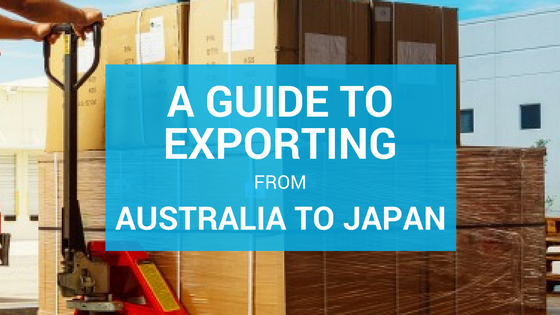A Guide To Exports To Japan From Australia
As you are considering to export products from Australia to Japan, this guide will give you a great starting point. Exporting your goods is a great way to build your brand and expand your business.
According to the Department of Foreign Affairs and Trade, Japan is the 2nd largest market of Australian exports. Major exports include coal, iron and copper ores and beef.
If you wish to learn more about getting your business ready to export, read our guide to exporting from Australia. It will help you understand what it takes to export to an international market, costs involved as well as access to valuable resources.
There’s also lots of fantastic advice for exporting to Japan here.

In this guide we’ll cover:
- Finding the right products to export to Japan.
- Understanding the types of products you can (and can’t) export.
- The best ways to export products to Japan.
- Costs to export containers from Australia to Japan.
- Understanding licenses for exporting to Japan.
- Export and import duty, tariffs, and taxes.
- Getting paid in foreign currency
Finding the right products to export to Japan
Having a successful exporting business requires a demand for product you are exporting to Japan. It’s important to know that Japan is a larger manufacturer of low cost products and it could be a tough competition if you’re bringing in similar products already available.
- Avoid food and perishables — Food and produce are very expensive to export, since you need specialised shipping. Additionally, food exports are subject to strict criteria, so you’re best off avoiding them altogether.
- Avoid mass-produced, cheap goods — Japan makes so many of these types of goods domestically, you’re never going to compete when you factor in the costs of manufacturing and logistics.
- Do your market research — Rakuten and Alibaba, both enormous online marketplaces, have a huge presence in Japan — You can certainly sell through these marketplaces, and they’re a good place to start when it comes to market research. Additionally, look into specialized market reports on what sells in Japan.
- Aim at unique products — Ideally, you’ll want to provide “unique” items that aren’t produced domestically in Japan. These can be lifestyle goods and aspirational products, often with a strong aesthetic. Think clothes, furniture, cars, electronics, accessories, and designer items.
- Understand your margins and pricing — Exporting can eat into your margins. Make sure you’ve got a rock-solid understanding of all your costs and the price you want to sell at. Then account for exchange rates to make sure you can still turn a profit.

Understanding the types of products you can and can’t export to Japan
Both Australia and Japan have limitations on what you can export and import.
Australia export restrictions
The Australian authorities prevent or restrict goods like some chemicals, biological materials, pharmaceuticals, animal and plant species, weapons, and more from export. You can find a complete list here. You should also learn what Australian Customs needs from you if you want to export.
Japan import restrictions
The Japanese authorities prohibit certain types of goods being imported including firearms, ammunition, explosives, germs (bio-terrorism), illicit drugs, counterfeit currency, and media / materials that are obscene or immoral, articles that infringe intellectual property.
The best ways to export products to Japan
International shipping and exporting to Japan for the first time can be complicating. It could be worth hiring someone who has experience in that area to help you.
Generally, this is the process involved:
- You manufacture or purchase the items domestically, in Australia OR you manufacture them elsewhere and arrange for shipping from there to Japan.
- You understand the various regulations, tariffs, and licenses you need to export.
- You arrange for international shipping from the point of origin to Japan — For larger items and big quantities, you will typically use container cargo, for smaller quantities, you might use an international shipper like FedEx.
- On arrival of your goods in Japan you pay the necessary duty, tariffs, and any other fees.
- You arrange for your goods to be held on your behalf in Japan.
- You market your goods for sale in Japan, often through a retail store, third-party marketplace, ecommerce website, or some other outlet.
- You sell your goods and arrange for them to be sent to your customers.
- You get paid and transfer your money back to Australia.
- You pay any necessary local taxes in Japan and Australia.

Typical container costs — Shipping from Australia to Japan
International shipping might not be as expensive as you think. According to the Sea Freight Calculator, the cost of renting a full container to ship goods from Australia to Hong Kong is approximately:
20 ft container — $1,600 USD
40 ft container — $2,000 USD
And according to Australia Trade, renting part of a container will cost you between $150 and $250 AUD per cubic meter or 1,000 kilos, whichever is greater.
Remember that these are only shipping costs — The cost of actually having your goods freighted from one port to another. They don’t include costs involved in getting your goods to a warehouse, insurance, duties, and other fees. Make sure you understand your total logistics costs so you can factor them into your pricing.
We’d advise you to compare a number of quotes from shipping companies and suppliers based on the type and quantity of goods you want to export.
Understanding licenses for exporting to Japan
The type of documents you need to clear Japanese customs are an export permit, invoice and declaration.
There are 15 laws and regulations that concerns exports these are: export trade control order, export exchange control order, export-import trading law, law for the protection of cultural properties, forest seeding law, law concerning wildlife protection and hunting, narcotics and psychotropics control law, cannabis control law, opium law, stimulant drug control law.
Note that the rules and regulations around importing and exporting to and from Japan do change from time to time. Make sure you check with official sources to ensure you’ve always got the latest information.
Export and import tariffs, duties, and taxes for Japan
Here are some estimates for the typical fees you’ll need to pay to import goods into Japan. You typically won’t have to pay goods and services tax to Australian authorities for exporting from the country, although you may need to pay some processing fees.
In Japan, you’ll likely have to pay the following:
- Consumption tax — 8% imposed on all goods imported into Japan.
- Other Internal Taxes — Also referred to as ‘excise tax’, this is imposed on certain types of products like liquour, tobacco products, petroleum and LPG.
- General Rate — Basic rates based on the Customs Tariff Law.
- Temporary Rate — Can be imposed in place of general rates for certain periods of time.
- Customs and import duties — Duties come in various different flavours and amounts. Rather than provide an exhaustive list here, you can find a good overview on this website. For an idea of the average amount you’ll need to pay, this piece provides some useful facts and figures.
As you can see, there is some work involved in exporting to Japan, but if you’ve already made good inroads into the Australian domestic market, it can be a great next step. Make sure you do your research, understand what you’re getting into, and plan carefully. Then you’ll be ready to launch, and sell your products.
What about receiving money in foreign currency?
Japanese businesses will typically pay you in either US dollars or Japanese Yen. If you are selling goods into Japan, consider using the Wise Account (formerly TransferWise).
Until recently, Australian businesses had 3 options to receive money from overseas customers:
- Get paid into a local Australian based, Australian dollar account.
- Open a Foreign Currency Account, usually with a bank
- Use a payment gateway like PayPal, Braintree or Stripe
Unfortunately, these options are usually filled with fees, balance requirements or massive exchange rate mark-ups.
Wise
In October 2017, Wise released the multi-currency account in Australia and it’s really impressive. It allows you to receive, hold and transfer 27 different currencies.
A unique feature that is particularly useful for businesses, is the ability to have local bank account details in USD, EUR, GBP or AUD. This makes receiving money from overseas customers exceptionally easy.
For the full review of the Wise multi-currency Account, click here
Learn more about the Wise Account
WorldFirst
There is a lot to like about the services that WorldFirst offer. WorldFirst could be especially a good option for businesses who currently use their regular bank for international payments. If your business needs to make regular or large payments, you might find that using a service like WorldFirst could help save a lot of money.
- Their website is easy to use. You should find that that set up and registration process is quite simple. This means you can be up and running, ready to make transfers in no time!
- They have competitive rates, and a lot of the time these will be better than what you'd find at your bank.
- For businesses, they have very competitive terms and offer specific support for online sellers.
- WorldFirst doesn't charge any fees. This makes calculating the cost of your transfer easier, as you only need to worry about the rate they are offering.
- They offer a number of products, including forward contracts if you're not constrained by time.
For the full review of WorldFirst, click here.